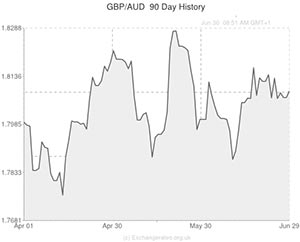
As a fresh week of trading began, the Pound to Australian Dollar (GBP/AUD) exchange rate was slightly stronger thanks to disappointing Down-Under data.
Although the ‘Aussie’ has been riding high against several of its most-traded currency counterparts since last week’s surprisingly upbeat Manufacturing PMI report for China, the commodity-driven asset lost some of its appeal after domestic housing data fell short of forecasts.
Australia’s New Home Sales report showed that sales declined by 4.3% in May, month-on-month, after climbing by 2.9% in April.
The drop was the first for five months, but did prompt this response from the Housing Industry Association’s chief economist; ‘The overall profile for new home sales is a healthy one, given that May marks the first decline in new home sales this year. Sales grew by 3.8% over the three months to May 2014 to be up by 21% compared to the same period in 2013. There’s a powerful impact to a recovery in new home construction that feeds through into the labour market which feeds into other parts of the economy. So when you do have a strongly growing new home building sector as we have had this year, and as we expect to have again next year, you do see some positive flow through impacts to other areas of the economy.’
Separate Australian data showed that Private Sector Credit in the nation increased by 0.4% in May, month-on-month, and was up 4.7% on the year.
The Australian Dollar was also feeling the pressure as a result of a risk-off environment generated in response to North Korea launching missiles on Sunday and the ongoing situation in Iraq. Ukraine remains a further source of geopolitical tension.
As well as easing slightly lower against the Pound, the Australian Dollar was a little softer against the US Dollar.
Meanwhile, today’s most influential UK report came in below expected levels as the European session progressed.
The data had little impact on the Pound to Australian Dollar exchange rate.
The UK Mortgage Approvals data revealed that approvals dropped to their lowest level for 11 months in May. The number of approvals issued slid from 62,806 in April to 61,707 in May. This was only slightly less than forecast but does add to other evidence that the UK’s overheating housing market is cooling.
As Monday some Pound support came in the form of comments issued by the Bank of England’s Deputy Governor Charlie Bean. Bean has adopted a comparatively hawkish position regarding interest rate increases in recent weeks, but will be leaving his current role at the end of this month.
During an interview for Sky Television Bean was quoted as saying; ‘The market has rates going up to 2.5% over the next three years. That seems like broadly sensible judgement. I wouldn’t want to say [rates will be at pre-crisis levels] in 10 years, but I think it’s plausible over the very long run […] that these headwinds will abate.’
As the day continues further modest movement in the Pound to Australian Dollar exchange rate could occur in response to US Pending Home Sales data and Canada’s GDP report.
Investors will also be looking ahead to the publication of Australia’s AiG Performance of Manufacturing Index and China’s Manufacturing PMI. If either of these measures impress, the Pound to Australian Dollar (GBP/AUD) exchange rate could shed recent gains.
UPDATED 06:40 GMT 01 July, 2014
Pound to Australian Dollar (GBP/AUD) Slides on Tuesday
The Pound to Australian Dollar (GBP/AUD) exchange rate declined during Australasian trading as the South Pacific currency was supported by domestic and global developments.
At its monthly policy meeting the Reserve Bank of Australia opted to hold interest rates at current levels and intimated that borrowing costs would remain on hold for some time.
This bolstered the ‘Aussie’ and the currency advanced further after China’s Manufacturing PMI jumped from 50.8 in May to 51.0 in June – pushing further above the 50 mark separating growth from contraction.
The second Chinese manufacturing gauge, compiled by HSBC) came slightly short of forecasts, easing to 50.7 from 50.8.
The GBP to AUD exchange rate could recover later today if the UK’s own Manufacturing PMI impresses.
Australian Dollar (AUD) Exchange Rates
[table width=”100%” colwidth=”50|50|50|50|50″ colalign=”left|left|left|left|left”]
Currency, ,Currency,Rate ,
Australian Dollar, ,US Dollar, 0.9402,
,US Dollar, 0.9402,
Australian Dollar, ,Euro, 0.6886,
,Euro, 0.6886,
Australian Dollar, ,Pound, 0.5523,
,Pound, 0.5523,
Australian Dollar, ,New Zealand Dollar, 1.0763,
,New Zealand Dollar, 1.0763,
US Dollar, ,Australian Dollar, 1.0641,
,Australian Dollar, 1.0641,
Euro, ,Australian Dollar, 1.4527,
,Australian Dollar, 1.4527,
Pound Sterling, ,Australian Dollar, 1.8115,
,Australian Dollar, 1.8115,
New Zealand Dollar, ,Australian Dollar, 0.9289,
,Australian Dollar, 0.9289,
[/table]

Comments are closed.